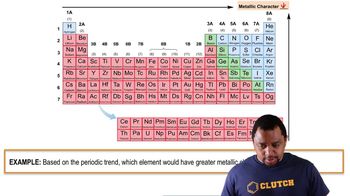Here are the essential concepts you must grasp in order to answer the question correctly.
Ionic Character
Ionic character refers to the degree to which a bond between two atoms exhibits ionic properties, as opposed to covalent properties. It is influenced by the difference in electronegativity between the two atoms involved in the bond. A higher ionic character indicates a greater transfer of electrons from one atom to another, resulting in the formation of charged ions.
Recommended video:
Metallic Character Example
Electronegativity Difference
Electronegativity is a measure of an atom's ability to attract and hold onto electrons in a chemical bond. The electronegativity difference between two bonded atoms can help predict the bond's character; larger differences typically indicate more ionic character. For example, a difference greater than 1.7 often suggests an ionic bond, while smaller differences indicate covalent bonding.
Recommended video:
Percent Ionic Character vs. Electronegativity Difference Graph
The graph plots percent ionic character against the electronegativity difference for various compounds, illustrating a trend where an increase in electronegativity difference correlates with higher percent ionic character. This visual representation helps in estimating the ionic character of specific bonds, such as the ClF bond, by locating its electronegativity difference on the x-axis and determining the corresponding ionic character on the y-axis.
Recommended video:
Metallic Character Example


 Verified step by step guidance
Verified step by step guidance


